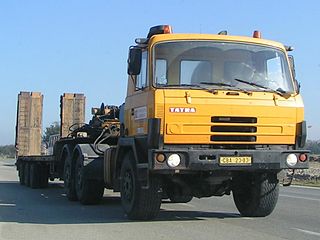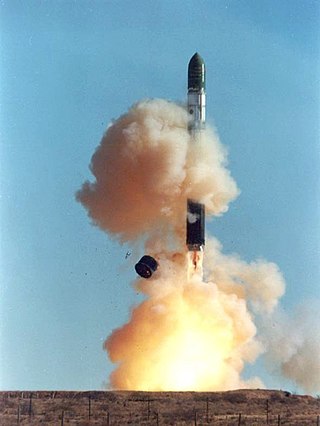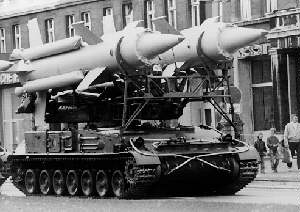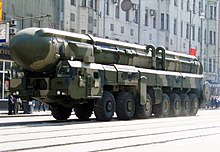
The Tatra 815 is a truck family, produced by Czech company Tatra. It uses the traditional Tatra concept of rigid backbone tube and swinging half-axles giving independent suspension. The vehicles are available in 4x4, 6x6, 8x8, 10x8, 10x10, 12x8 and 12x12 variants. There are both air-cooled and liquid-cooled engines available with power ranging from 230–440 kilowatts (310–590 hp). As a successor to Tatra 813 it was originally designed for extreme off-road conditions, while nowadays there are also variants designated for mixed use. The gross weight is up to 35,500 kg (78,264 lb).

The RT-2PM2 «Topol-M» is one of the most recent intercontinental ballistic missiles to be deployed by Russia, and the first to be developed after the dissolution of the Soviet Union. It was developed from the RT-2PM Topol mobile intercontinental ballistic missile.

The R-36 is a family of intercontinental ballistic missiles (ICBMs) and space launch vehicles (Tsyklon) designed by the Soviet Union during the Cold War. The original R-36 was deployed under the GRAU index 8K67 and was given the NATO reporting name SS-9 Scarp. It was able to carry three warheads and was the first Soviet MRV missile. The later version, the R-36M, also known as RS20, was produced under the GRAU designations 15A14 and 15A18 and was given the NATO reporting name SS-18 Satan. This missile was viewed by certain United States analysts as giving the Soviet Union first strike advantage over the U.S., particularly because of its rapid silo-reload ability, very heavy throw weight and extremely large number of re-entry vehicles. Some versions of the R-36M were deployed with 10 warheads and up to 40 penetration aids and the missile's high throw-weight made it theoretically capable of carrying more warheads or penetration aids. Contemporary U.S. missiles, such as the Minuteman III, carried up to three warheads at most.

The RT-2PM Topol was a mobile intercontinental ballistic missile designed in the Soviet Union and in service with Russia's Strategic Missile Troops. As of 2014, Russia planned to replace all RT-2PM ICBMs with versions of Topol-M. In December 2023, the last Topol regiment was taken off combat duty.

The RT-23 Molodets was a cold-launched, three-stage, solid-fueled intercontinental ballistic missile developed and produced before 1991 by the Yuzhnoye Design Bureau in Dnipro, Soviet Union. It came in silo- and rail-based variants, and was armed with 10 MIRV warheads of 550 kt yield. All missiles were decommissioned by 2005 in accordance with the START II.

A transporter erector launcher (TEL) is a missile vehicle with an integrated tractor unit that can transport, elevate to a firing position and launch one or more rockets or missiles.
The RT-21 Temp 2S was a mobile intercontinental ballistic missile developed by the Soviet Union during the Cold War. It was assigned the NATO reporting name SS-16 Sinner and carried the industry designation 15Zh42 (15Ж42).

Minsk Automobile Plant (MAZ) is a state-run automotive manufacturer association in Belarus, one of the largest in Eastern Europe.

The BM-30 Smerch, 9K58 Smerch or 9A52-2 Smerch-M is a heavy self-propelled 300 mm multiple rocket launcher designed in the Soviet Union to fire a full load of 12 solid-fuelled projectiles. The system is intended to defeat personnel, armored, and soft targets in concentration areas, artillery batteries, command posts and ammunition depots. It was designed in the early 1980s and entered service in the Soviet Army in 1989. When first observed by the West in 1983, it received the code MRL 280mm M1983. It continues in use by Russia; a program to replace it with the Tornado-S began in 2018.

Start-1 is a Russian satellite launch vehicle based on the RT-2PM Topol, a Soviet intercontinental ballistic missile developed by Moscow Institute of Thermal Technology.
The MAZ-543/MAZ-7310 "Uragan" is a Soviet/Belarusian 8×8 artillery truck designed and developed by MAZ, in what is now Belarus.

MZKT is a manufacturer of heavy off-road vehicles, especially military trucks, based in Minsk, in Belarus; it was formerly a division of MAZ. MZKT civilian trucks are branded VOLAT. MZKT specializes in the production of on-road and off-road heavy-duty vehicles and trailers for them, as well as special wheeled chassis for installation of various equipment for enterprises and transport organizations of the construction, oil and gas and engineering industries.

A missile vehicle, also known as a missile carrier, missile truck, or missile launcher vehicle, is a military vehicle that is purpose-built and designed to carry missiles, either for safe transportation or for launching missiles in combat. Missile vehicles include transporter erector launchers (TEL) and multiple rocket launchers (MRL).

The MZKT-79221 is a Soviet and Russian army 16x16 transporter-erector-launcher designed and developed by the MZKT in Belarus.

MAZ-5335 is a Soviet truck, manufactured at the Minsk Automobile Plant from 1977 to 1990.

The GAZ-3310 Valdai is a medium-class flat bed truck formerly produced from late 2004 until 2015 at the Gorky Automobile Plant in Russia. It differs from the "GAZelle" light commercial vehicle in that it does require a category C driver's license. The production of the truck ended in December 2015.

The Belkommunmash BKM-321 is a Belarusian large capacity low-floor trolleybus for intracity passenger transportation, mass-produced since 2003. It belongs to the third generation of trolleybuses developed by the Belkommunmash plant in Minsk.

Belarus had third by volume part of automotive industry of the Soviet Union with near 40,000 annual production. Since that times Belarus specializes on production of own designed superheavy, heavy and middle trucks mainly plus post-Soviet developed buses, trolleybuses and trams. Auto manufacturers in Belarus include MAZ, BelAZ and Neman.

KAMAZ-7850 (Platforma-O) is a new unified family of wheeled very heavy load transporters developed by KAMAZ for the Russian Ministry of Defence. It will replace the Belarusian-made MZKT transporter erector launchers that are currently carrying Russian ICBMs. Platforma-O comprises KAMAZ-7850 16x16 vehicle with a capacity of 85 t, KAMAZ-78509 12x12 with a capacity of 60 t, KAMAZ-78504 8x8 capable for towing of a 90 t semi-trailer, and KAMAZ-78508 8x8 for the transportation of aircraft on airfields. One of the applications will be carrying RS-24 Yars missiles. State tests were completed in August 2018 and it entered service in March 2019. The Russian military is to receive five versions of the vehicle, namely, 8x8, 12x12 and 16x16 heavy transporters with payload capacities of 25 t, 50 t, and 85 t, respectively, an 8x8 semi-trailer with a towing capacity of 165 t, and an 8x8 ballast tractor with a towing capacity of 400 t. The 12x12 and 16x16 tractors will be used as transporter erector launchers, while other vehicles will carry various support systems.

The MAZ-215 is a Belarusian low-floor articulated bus from the Minsk Automobile Plant. The vehicle is an articulated bus with a driven central axle and corresponding to a drive formula of 6 × 2 (2). It is the successor of the MAZ-205.
















